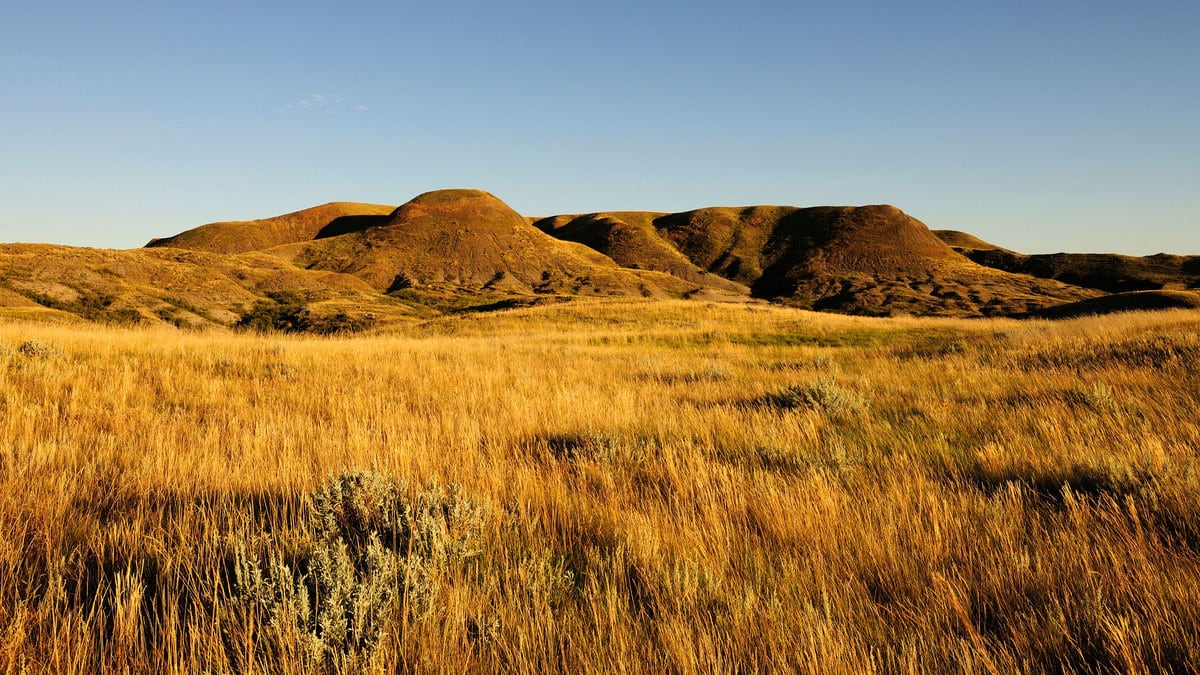Few people know that after Chief Sitting Bull decimated Custer and his troops at the Battle of the Little Bighorn, he headed to Canada in 1877. Pleased with the civil Canadian greeting and abundant bison he settled his Lakota followers in the rolling hills and short-grass prairies of southwest Saskatchewan. The bison were gone after four years—felled by hide hunters and overhunting to make room for European settlers—and U.S. government representatives convinced Chief Sitting Bull to move to a South Dakota reserve.
Not everyone followed Sitting Bull back to the U.S. Descendants of the Lakota can still be found in the area surrounding Canada’s Grasslands National Park in Saskatchewan, a historic connection that surprises the hardy 12,000 travelers that visit the remote park each year.
But there is much to be surprised about in one of Canada’s newest national parks, created in 1981. I started my explorations with a time-travel-themed hike in the park’s east block, one of the best places in the world to see the line of extinction, a geological punctuation mark on the age of dinosaurs.
Labeled the quietest grasslands on earth by acoustic ecologist Gordon Hempton, there’s few planes passing overhead even though this park is near the geographic center of North America.
The area offers understated wildness; rare prairie critters like burrowing owls and Greater Short-horned lizard hard to find elsewhere, peek out of dusty hillsides and shaggy grasslands. Quicksand, venomous snakes, and cantankerous bison remind you this is a park that can hurt you but it’s worth the risk to hike across grasslands bereft of fences or buildings or wander coulees with some of Canada’s richest dinosaur beds—a new prehistoric bird species was found here only eight years ago. The only towns you’ll see are occupied by prairie dogs and when the sun sets on the darkest of Canada’s dark sky preserves, you’ll be gobsmacked by ribbons of stars draped across the sky.
It’s a five-hour-drive from the nearest airport and the road potholes will resettle your fillings.
Nobody just drops in. You have to want to be here.
My guide, Corelie Keller, is no exception. Finding her fortune in the oil industry she returned home to care for her mother on the century-old family farm. Now she has channeled her communication skills and love of the rolling hills into a seasonal gig interpreting Grasslands National Parks.
“Do you have pliers with you?” she queried a woman with a small dog, “There’s a lot of cactus out there.” At the bewildered look passed between dog lover and her human companion, Keller stepped back into the Parks Canada office, emerging shortly after with leather gloves and a pair of pliers poking out of her back pocket.
Cresting a grassy knoll, she points to the hoodoos (tall, thin spires of rock) and canyons visible in the distance. “That’s the Valley of 1,000 Devils. There’s a black line along some of the ravines. Below the line you will find evidence of dinosaurs. Above that line, no dinosaurs!” she exclaimed, pausing to extract a large cactus quill from a woman’s shoe, and then describing the theory of how an asteroid hitting Mexico’s Yucatan Peninsula caused a mass extinction of dinosaurs.

Reintroduced bison herds are growing rapidly in the park.
Carol PattersonThe wind whistled across the hill carrying a meadowlark’s song as we walked past the remains of a homesteader’s cabin. Under the 1872 Dominion Lands Act settlers got cheap land if they cultivated 40 of 160 acres. But it was the people not the land who usually broke. Those that succeeded grazed the land and focused on cattle, not plows.
“Do you ever see UFOs?” I inquired, thinking if there were a place where a flying saucer could land unnoticed, this would be it. “Sure, a couple of times,” retorted Keller without missing a beat. “The old-timers can also tell you about the mysterious happenings during Al Capone’s era. People had garages on their property that they rented to people in the liquor trade.” During the Prohibition era, the region’s proximity to the Canada/U.S. border made it a good place to smuggle booze. “Cars would drive up, the garage doors would open, the cars would go in, and the doors would close (to load or unload liquor). A short while later the doors would open and the cars would drive away.”
History lies under every footstep in these prairies. We worked our way up a high ridge to stand among a circle of stones. “This is a teepee ring,” Keller explained, “First Nation people would have camped here and used the stones to hold down the walls of their teepees.” I could see for miles in every direction and imagined Chief Sitting Bull might have found this a good spot to look for bison or unwanted visitors.
As I checked into nearby Rock Creek Campground the attendant confirmed that Chief Sitting Bull’s descendants still live in the area. “One of our coworkers is a descendant of Sitting Bull. He performs a special ceremony when we put up teepees in the park,” she divulged.
I had the chance later to talk to Kathy Grant, a woman of Métis (mixed European and Indigenous) ancestry who works for Parks Canada to build relationships with indigenous people. “Part of my role is to reach out to indigenous groups that have had historical connections with (land that is now) the park. Their ancestors probably hunted here. Mine certainly did.”
Grant’s great-grandfather rode in the last bison hunt in the area in the mid-1880s, but her connection to the park came from her son who worked as a summer park interpreter. “As we were growing up we heard about this national park coming. I didn’t really have any feelings one way or the other about it. Maybe some curiosity.” When her son got a summer job at the park, Grant recalled, ”I was intrigued by how he was telling the story of the park. I was fascinated. There was so much more I needed to learn.” And learn she did, starting as a park interpreter in 2008.
In her newest role Grant is expanding interpretation of indigenous culture. “For this season I will help coordinate a new program called Metis connections that will showcase Metis culture through storytelling, interpretation, music and art.”
The park was created from land voluntarily sold by ranchers and covers an area one-tenth the size of Yellowstone National Park. It’s the only Canadian national park to protect prairie grasslands. It’s split into two blocks; the east block popular with paleontology lovers and astronomy buffs, the west block more beloved by wildlife lovers. Having explored the east block I headed to west to see bison herds and the only place in Canada where I could see the black-tailed prairie dog.
Stopping for hiking information I discovered rattlesnakes are also common here. “Would you like to borrow snake guards for hiking?” asked the helpful woman at the visitor center before confirming the closest rattlesnake anti-venom was a bumpy two-hour ride away. “Sure,” I yelped, realizing this was a park that could hurt you. A recent outbreak of sylvatic plague (related to the bubonic plague) in a prairie dog colony had Parks Canada telling visitors to avoid the part of the park.
Considering my risks managed, I took my snake guards and headed to the 70-Mile Butte trailhead named by the North-West Mounted Police patrolling the area a century earlier because the butte was easy to spot and was seventy miles west of Wood Mountain Post and seventy miles east of Eastend Post. Luckily my hike would be just over two miles. A six-foot Bull Snake slithered across the trail as I strode by, wondering if my camouflage-patterned-snake guards made me less visible to reptiles, and hoping to see no rattlers.
I crested the butte and looked south to Montana from where Sitting Bull had come at a time when bison were slaughtered and little thought given to the rights of indigenous people. Now, bison populations are growing and there’s new reconciliation with First Nations. While just a start, I think it’s fitting for a place that offered Sitting Bull respite 143 years ago.






